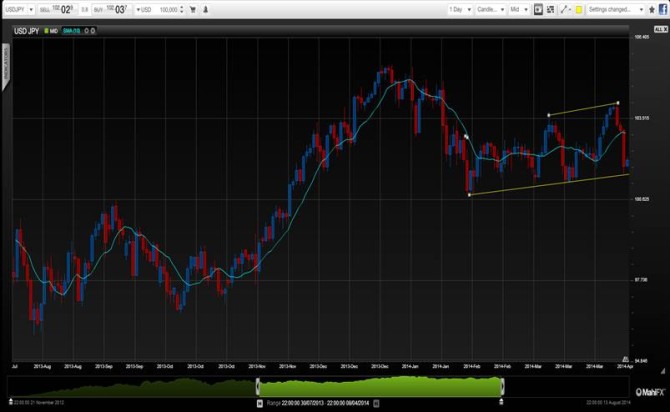The Bank of Japan disappointed JPY bears with its assessment that it is on track in achieving its 2% inflation target. However more stimulus is very likely probably from late Summer suggesting that the bear market for the Japanese currency will resume soon.
The monetary expansion programme from the BoJ is already substantial running at 60 trillion-70 trillion yen a year (around $580-680 billion) and it has been moving the dial on inflation and GDP growth.
However, once established deflationary forces are hard to shift and they are still very much alive in the Japanese economy.
By Justin Pugsley, Markets Analyst MahiFX. Follow @MahiFX on twitter
But the economy now faces a new challenge. The country’s consumption tax rose to 8% from 5% this month – a move that has been delayed for many years for fear of hurting the economy. And what happens to domestic consumption is important, because it makes up around 60% of GDP.
USD/JPY – could test support at 100, but longer-term target 110

Demographic deflation
But the much bigger problem in Japan is demographics. It’s population is ageing at an alarming rate with a quarter over the age of 65 and that rises to 38% by 2050. This presents a major deflationary drag on the economy. Over 65s generally tend to spend less than their younger counterparts and claim more healthcare and welfare benefits.
With the old outnumbering children the population is actually set to shrink year on year for decades.
In the absence of mass immigration, something Japan is against, stimulating long-term sustainable GDP growth and inflation will be a major challenge – and one ultimately beyond the powers of the BoJ. The recent up-tick in GDP is therefore likely to be temporary.
There are some solutions that can help such as raising the retirement age and boosting productivity (difficult). Boosting exports can also help, but international trade is a relatively small part of the economy compared with domestic consumption.
The previous governor of the BoJ Masaaki Shirakawa was well aware of the demographic problems and warned about the limits of central bank stimulus programmes.
But Japan has another chronic problem – its debt to GDP ratio is around 230% and the government spends more than it takes in via taxes, meaning the fiscal position is unsustainable.
Given the severe demographic headwinds the real reason behind the BoJ’s actions is probably to ensure the debt is eroded via mild inflation. Also, placing government bonds on the BoJ’s balance sheet with coupons on those bonds paid back to the Japanese Treasury – it effectively lowers the debt burden.
It is very likely that the BoJ will remain very interventionist for many years to come and the outlook for JPY is hardly bullish.
Further reading: USDJPY forecast
